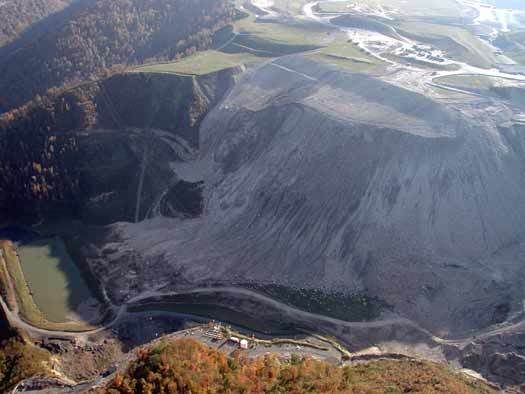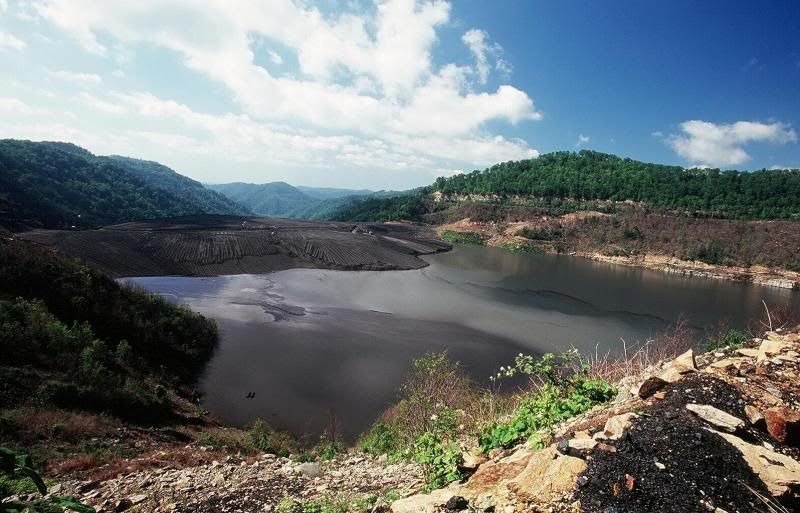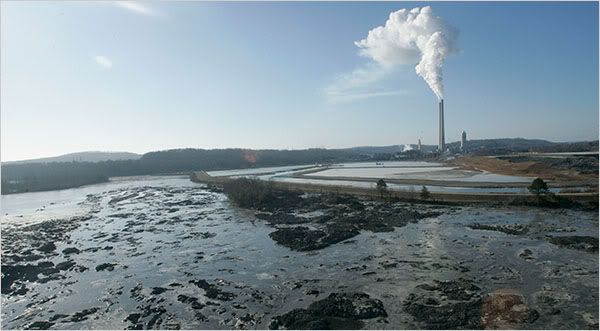( – promoted by buhdydharma )
 Mountaintop removal mining dumps tons of waste into streams and eco systems that are literally killed by suffocation. Mining companies claim their euphemistic “valley fills” are an industry necessity because it would be too expensive to pay for waste disposal. If Congress outlaws “valley fills,” it would help stop MTR mining, which causes massive environmental disasters and violates human rights.
Mountaintop removal mining dumps tons of waste into streams and eco systems that are literally killed by suffocation. Mining companies claim their euphemistic “valley fills” are an industry necessity because it would be too expensive to pay for waste disposal. If Congress outlaws “valley fills,” it would help stop MTR mining, which causes massive environmental disasters and violates human rights.
A clear definition of “fill material,” which affects what can be discharged into our waters, can be used to stop “valley fills”. The government admitted that the Corps’ definition prohibited valley fills. The EPA later adopted a definition to allow valley fills. The inconsistency and confusion between these two rules was seized as cover to issue permits for valley fills. After environmental groups obtained injunctive relief against MTR mining based on the Corps’ definition, Bush changed the law. Bush’s definition of fill material is based on the EPA rule. The problem with HR 1310 is that it is based on the same rule used by the EPA and Bush. Instead of clarity, we have muddy waters ripe for more years of litigation delaying the end of MTR.
 The purpose of HR 1310 is to “clarify that fill material cannot be comprised of waste.” However, the inconsistency cloud hanging over fill material law was based on the EPA Rule that conflicted with both the Corps Rule and legislative history. HR 1310 muddies the fill material law by adopting the EPA Rule tests that allowed waste discharges, then adding part of the Corps Rule that banned waste discharge, but wrapping up with ignoring the other Bush Rule that expressly authorizes mining waste discharges. Law is not a ball game, but HR 1310 has 3 parts allowing mining waste and one part banning.
The purpose of HR 1310 is to “clarify that fill material cannot be comprised of waste.” However, the inconsistency cloud hanging over fill material law was based on the EPA Rule that conflicted with both the Corps Rule and legislative history. HR 1310 muddies the fill material law by adopting the EPA Rule tests that allowed waste discharges, then adding part of the Corps Rule that banned waste discharge, but wrapping up with ignoring the other Bush Rule that expressly authorizes mining waste discharges. Law is not a ball game, but HR 1310 has 3 parts allowing mining waste and one part banning.
The Clean Water Protection Act or HR 1310 provides:
FILL MATERIAL- The term ‘fill material’ means any pollutant which replaces portions of the waters of the United States with dry land or which changes the bottom elevation of a water body for any purpose. The term does not include any pollutant discharged into the water primarily to dispose of waste.’
After HR 1310 becomes a law, the federal agencies will adopt new rules to implement it, which can take “a few months to several years” to complete the regulatory process (pdf file). In the interim, the federal agencies and the courts will use the existing body of judicial opinions and legislative history to interpret HR 1310 in the permitting process.
These are the key components of HR 1310 that must be interpreted:
(1) Any pollutant. Limiting fill material to any pollutant is good. The CWA jurisdiction is based on the discharge of pollutants, which are defined to include a number of materials, including MTR mining waste, such as rock and sand.
(2) Which replaces portions of the waters of the United States with dry land or which changes the bottom elevation of a water body.
This is the horrendous sham effects test that allows our waters to be used as dump sites. HR 1310 has the identical effects test that was the heart of the 1988 EPA Rule that allowed valley fills by defining fill material as:
“any pollutant which replaces portions of the waters of the United States with dry land or which changes the bottom elevation of a water body for any purpose.” 40 C.F.R. § 232.2
The quoted phrase is known as the effects test. If the effect of filling a water body with a pollutant is to replace water with dry land or change the bottom elevation, then the discharger may apply for a Corps permit.
The courts recognized that this is a tautological test that any fill material can pass because all fills have the effect of filling. By expunging the primary purpose/beneficial use doctrines in the Corps Rule, the effects test allows our waters to be filled, polluted and destroyed for any purpose, including waste disposal.
The 2002 Bush Rule also defines fill material with the effects test. Bush also redefined a key sister rule to fill material by including mining waste in the definition of “discharge of fill material.”
 These rules are not limited to MTR mining, but are used nationwide to legalize the industry practice of dumping mining waste into lakes, streams and wetlands. In a case now before the US Supreme Court, the 9th Circuit admitted that Bush’s effect test was facially satisfied because the effect of discharging slurry and gold mine tailings into a lake in our national forest will be to raise the bottom elevation of the lake by 50 feet. The gold mining company and the Corps admit that the discharge will kill all the fish and aquatic life, yet the Corps issued the permit because it satisfied the effects test, which is the test under the EPA Rule, the Bush Rule and HR 1310. The 9th Circuit revoked the permit on other grounds.
These rules are not limited to MTR mining, but are used nationwide to legalize the industry practice of dumping mining waste into lakes, streams and wetlands. In a case now before the US Supreme Court, the 9th Circuit admitted that Bush’s effect test was facially satisfied because the effect of discharging slurry and gold mine tailings into a lake in our national forest will be to raise the bottom elevation of the lake by 50 feet. The gold mining company and the Corps admit that the discharge will kill all the fish and aquatic life, yet the Corps issued the permit because it satisfied the effects test, which is the test under the EPA Rule, the Bush Rule and HR 1310. The 9th Circuit revoked the permit on other grounds.
(3) For any purpose.
The second bad component of HR 1310 is its adoption of the EPA Rule of discharge “for any purpose.” As long as the mining waste tossed into a stream has the effect of filling the stream, then it can be done “for any purpose.”
(4) The term does not include any pollutant discharged into the water primarily to dispose of waste.
This 4th element has been the law since at least 1977 when the Corps issued its rule on fill material, yet the federal agencies issued permits to mining companies for valley fills. The mining companies argued that there was inconsistency between the Corps Rule and the EPA Rule. This inconsistency remains under HR 1310, which is 2 parts EPA Rule (effects and any purpose tests) and one part Corps Rule (primarily waste disposal ban). Another inconsistency existed between the EPA Rule tests and legislative history, which is consistent with the Corps Rule. This confusion remains because HR 1310 is based on the EPA Rule. Finally, HR 1310 creates a third ambiguity ammunition that mining companies may grab because HR 1310 bans discharges primarily to dispose of waste while ignoring that Bush also redefined “discharge of fill material” to expressly include the addition or discharge of fill material into waters of the US, including the “placement of overburden, slurry, or tailings or similar mining-related materials.”
Moreover, even if a court upholds HR 1310 as banning discharges primarily for waste disposal, the mining companies can simply bite the bullet and pay for legitimate waste disposal or find a way to continue discharges where the waste disposal is “defined” as a secondary rather than a primary purpose.
 This is already happening with another harmful and deadly component of MTR mining, the coal sludge impoundments or “ponds”. In order to reduce the coal shipping costs, impurities are removed by processing the coal, and this liquid coal mining waste is discharged into sludge or slurry “ponds”. Coal mining companies then construct dams with the solid mining waste (rocks and soil) to impound the liquid coal waste. In this case, the primary purpose is not waste disposal, but the construction of a dam or slurry “pond”.
This is already happening with another harmful and deadly component of MTR mining, the coal sludge impoundments or “ponds”. In order to reduce the coal shipping costs, impurities are removed by processing the coal, and this liquid coal mining waste is discharged into sludge or slurry “ponds”. Coal mining companies then construct dams with the solid mining waste (rocks and soil) to impound the liquid coal waste. In this case, the primary purpose is not waste disposal, but the construction of a dam or slurry “pond”.
(5) HR 1310 does not use the primary purpose/ beneficial uses test of the Corps Rule.
Since 1977, the Corps has defined “fill material” as:
“any material used for the primary purpose of replacing an aquatic area with dry land or of changing the bottom elevation of a waterbody. The term does not include any pollutant discharged into the water primarily to dispose of waste, as that activity is regulated under section 402 of the Clean Water Act.” 33 C.F.R. § 323.2(e)
The Bush Rule is not based on this rule because the Corp admitted in court that its rule prohibited permits for valley fills. [Kentuckians for the Commonwealth. v. Rivenburgh(S.D. W. Va. 2002) 204 F. Supp. 2d 927] It was the primary purpose/beneficial use test in combination with the waste discharge ban that rendered valley fills illegal.
Under the Corps Rule, the primary purpose of the fill material is construction of new beneficial uses of approved structures — such as levees, dams or breakwaters — that replace an aquatic area with dry land or change the bottom elevation of a waterway. The fill material is discharged in an incidental or secondary role for the primary beneficial purposes of construction, development or property protection of specified structures that are consistent with the Corps’ traditional functions of protecting our coastlines or ports. It is the beneficial use that does not impair water quality that justified filling US waters.
 The primary purpose/beneficial uses test would prohibit valley fills and slurry ponds as well as the coal fly ash “ponds”. Remember the Tennessee coal ash pond that ruptured last December, flooding 300 acres with a billion gallons of toxic sludge? The Tennessee coal ash pond is one of 1,300 dump sites nationwide.
The primary purpose/beneficial uses test would prohibit valley fills and slurry ponds as well as the coal fly ash “ponds”. Remember the Tennessee coal ash pond that ruptured last December, flooding 300 acres with a billion gallons of toxic sludge? The Tennessee coal ash pond is one of 1,300 dump sites nationwide.
New Legislative Proposal
The upshot is that interpretation of HR 1310 may be confusing: The intent of HR 1310 requires consistency with the Corps Rule, but the express mandate of HR 1310 requires consistency with the EPA Rule.
HR 1310 was drafted during the Bush years but things have changed since then. We have the WH and sponsors who want to end MTR. Why not enact a law that is not based on the same ambiguities and inconsistencies that have allowed valley fills in the past?
This is my proposal, which is basically the Corps Rule updated to reverse Bush’s new definition of discharge of fill material and has changes from HR 1310 highlighted in bold:
FILL MATERIAL – The term fill material means any pollutant used for the primary purpose of replacing an aquatic area with dry land or of changing the bottom elevation of a water of the United States for beneficial uses. The term does not include any pollutant discharged into the water primarily to dispose of waste, as that activity is regulated under section 402 of the Clean Water Act. Fill material does not include overburden, slurry, sludge, tailings or similar mining-related waste or materials, placer mining wastes, phosphate mining wastes, titanium mining wastes, sand and gravel wastes, fly ash, drilling muds and related materials.

1 comments
Author
then what is the point? why not enact a law that will clearly and unequivocally stop MTR rather than accepting some precompromise. shit, we won the election this time.